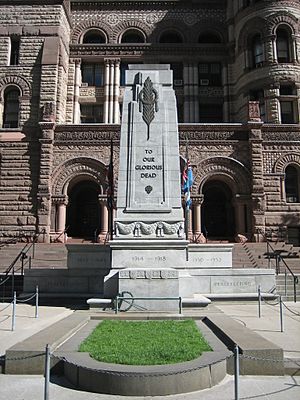Old City Hall Cenotaph, Toronto facts for kids
| (Old City Hall Cenotaph) | |

The cenotaph outside of Old City Hall
|
|
| Coordinates | 43°39′07.70″N 079°22′54.21″W / 43.6521389°N 79.3817250°W |
|---|---|
| Location | Toronto, Ontario |
| Designer | W.M. Ferguson and T.C. Pomphrey |
| Type | War memorial |
| Material | Granite |
| Beginning date | 1924 |
| Completion date | 1925 |
| Opening date | November 11, 1925 |
| Dedicated to | Those who served in World War I, World War II and the Korean War |
The Old City Hall Cenotaph is a special memorial located right in front of Old City Hall in Toronto, Ontario, Canada. It stands as a tribute to people from Toronto who bravely served and lost their lives in wars.
This monument was first built after World War I. Later, it was also dedicated to those who died in World War II and the Korean War. It helps us remember their courage and sacrifice.
Contents
What is a Cenotaph?
A cenotaph is a monument that looks like a tomb, but it doesn't actually hold a body. The word "cenotaph" comes from ancient Greek words meaning "empty tomb." It's a place to honor people who died, especially those buried far away or whose graves are unknown.
Why Was It Built?
After World War I, people wanted a lasting way to remember the soldiers who died. Since 1919, a temporary wooden structure was used for Remembrance Day ceremonies. Toronto City Council decided to build a permanent memorial. They asked architects to submit designs.
Fifty different designs were sent in. The one chosen was by an architectural firm called Ferguson/Pomphrey. Their design was picked to create this important monument.
Designing the Memorial
The designers, W.M. Ferguson and T.C. Pomphrey, were architects from Toronto. They created a monument that looks like The Cenotaph at Whitehall in London, England. This design was chosen in 1924.
The Toronto Cenotaph is made from strong granite stone. This granite came from the Canadian Shield, a very old and rocky part of Canada. The whole project cost about $25,000, and the architects received $2,500 for their work. The monument was finished on time and within budget.
A Change in Words
Before the cenotaph was officially opened, there was a discussion about what words should be carved on it. The first idea was to simply say "TO ALL WHO SERVED." However, some people realized that a cenotaph is specifically for those who died.
Since it was an "empty tomb" honoring the dead, they felt "TO ALL WHO SERVED" wasn't quite right. After thinking it over, the original words were changed. The cenotaph now reads: "TO OUR GLORIOUS DEAD." This phrase better honors those who made the ultimate sacrifice.
Remembering the Fallen
The Toronto Cenotaph was officially opened on November 11, 1925. This date is important because it's Remembrance Day, a day when we remember soldiers who died in wars. A special stone was placed in the memorial by Field Marshall Haig on July 24, 1925. He was a very important military leader.
Today, the Old City Hall Cenotaph is one of the main places in Toronto where people gather for Remembrance Day ceremonies. It's a quiet and important spot where we can all pause and remember the brave people who served our country.

